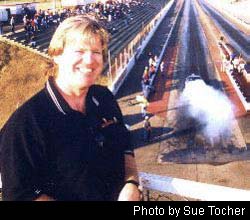
Wondering What Happens Next
9/20/06

 wo years ago, shortly after the inaugural American Drag Racing League (ADRL) Dragstock event at Carolina Dragway, I wondered in this space if I had just witnessed the start of something big. With the conclusion of Dragstock III this past weekend at Rockingham Dragway, I’m almost ready to stop wondering.
wo years ago, shortly after the inaugural American Drag Racing League (ADRL) Dragstock event at Carolina Dragway, I wondered in this space if I had just witnessed the start of something big. With the conclusion of Dragstock III this past weekend at Rockingham Dragway, I’m almost ready to stop wondering.
By now you’ve almost certainly heard of the record-setting crowds, record-shattering performances, and record-making pairings that punctuated the biggest two-day event in venerable Rockingham Dragway’s existence. It certainly was the biggest Pro Mod show ever held, the biggest eighth-mile race, and someone even suggested Dragstock III may have been the biggest non-nitro event in the history of drag racing, but I’ll leave that debate to those with longer memories of the sport than yours truly.
By some accounts 30,000-plus people streamed through the gates over Friday and Saturday, though I suspect a number somewhat over 20,000 is more realistic. Regardless, the place was packed, prompting one entrant to echo the comment you often hear from Indy 500 rookies after making their first pass down the main straight on raceday: “I was lined up there to go and all I could see was a black strip of pavement wedged between grandstands packed with people,” he said. “It was awesome!”
Awesome indeed, just as the 3.813-seconds pass at 198.44 mph laid down by Jason Scruggs was in the opening round of Pro Extreme eliminations. It stood up for new ADRL elapsed time and speed records after he backed it up with a 3.823/198.06 combo in the next round.
We didn’t see any three-second runs from the Pro Nitrous ranks, but several racers realized career-best passes and the fans were treated to the quickest side-by-side nitrous race in history when eventual race winner Shannon Jenkins ran 4.016 against longtime foe Rickie Smith’s 4.026 in the semis. Add to that the quickest eighth-mile pass in Outlaw 10.5 history (Pro 10.5 in ADRL speak) when Steve Kirk Jr. went 4.430 at 166.97 mph to qualify number one before going on to win the quickest and fastest 10-wide race ever when he beat Marcus Birt in the final round (4.463/166.21 over 4.495/163.59), and you have a genuinely historic event in the books.
By all accounts this was a tremendously successful event, with the only visible flaw being a significantly understaffed concession workforce that led to insufferably long lines for just a burger and a Coke. At mid-afternoon Saturday I even saw some fans heading to their cars for a trip to town and back from the local Mickey D’s since it was probably just as fast as waiting for track food.
And I’m not telling tales out of school here, either, as track owner Steve Earwood even felt compelled to get on the P.A. to apologize for the long waits, acknowledge he was unprepared for the massive crowd, and thank his patrons for their patience. In my opinion, though, it was the patience and effort of Earwood’s frontline workers that truly deserved his gratitude that day. I hope they got a bonus.
The ADRL clearly has a great product to sell and is able to put on quite a show, especially when partnered with professional track staff like those at The Rock. Obviously, the on-track action was impressive, but whether testing, qualifying, or racing, the lanes and rounds moved smoothly. Plus, downtime was kept to a minimum after the inevitable, but fortunately few clean-ups (and although we saw a couple of serious accidents, thankfully both drivers escaped injury).
Still, I’d suggest some sort of on-call entertainment is needed to help fill in those gaps. At least during a roundy-round caution the crowd (usually) gets to watch the cars circulate under a yellow flag. Drag racing fans are lucky to watch a yellow tractor spraying traction compound.
Perhaps a motorcycle stunt rider like the guy I saw at an Outlaw Racing Street Car Association (ORSCA) event just a week earlier could be retained, especially for those increasingly lengthy waits between rounds as fewer cars go down the track. The nature of Pro Mod racing requires a certain amount of prep time between rounds, so wholly predictable periods of boredom set in before the semis and finals are run. Without any bracket or Sportsman action to fill in like at an NHRA/IHRA national events, why not give the people something—anything—to watch while they wait?
And speaking of ORSCA, I think ADRL owes the Atlanta-based series a debt of gratitude for whipping the Outlaw 10.5 crowd into shape. Just three short years ago, most 10-wide racers in these parts were true outlaws, often racing in just shorts, T-shirts and helmets and sometimes cutting corners in other safety areas. Under ORSCA president Johnny Fenn’s vision to create a legitimate sanctioning body, the new series’ entrants and cars were subjected to NHRA licensing and certification requirements. Without ORSCA’s initiative, I believe Outlaw 10.5 wouldn’t even be a viable option for the expanded ADRL show.
As it is, I think the addition of the 10-wide class is now an ideal fit. The class is fast and hairy, the cars and teams look professional, and their performances are impressive but just different enough not to be confused with the Pro Mod entries. Plus, to a man (and woman), every 10.5 driver and team member I spoke with said they loved their ADRL experience and hoped it would become a regular part of their racing experience.
It’s not necessarily a no brainer, though. I have to wonder how many current 10.5 teams have the wherewithal and/or willingness to become part of ADRL’s traveling circus. Of course, it may not matter, as even the Pro Extreme and Pro Nitrous classes feature cadres of season-long entrants mixed in with local Pro Mod racers at each event. The ADRL Pro 10.5 class may have to start out with just a few big-name (translation: big-money) teams chasing the points and relying on regional entrants to fill out the fields next year. We’ll also see if the prestige of a potential championship will be enough to outweigh going after a big outlaw payday for some of the front runners if there are conflicting race dates next year.
Early in this piece I said I’m almost ready to stop wondering if the ADRL is on to something big. And I say “almost” only because I think the series still has to demonstrate staying power before it justifies jumping on the bandwagon.
I’ve been to some absolutely fantastic ADRL events, but I’ve also been to a couple that were, quite frankly, disappointing. The racing has always been top notch, mind you, but for various reasons—weather, venue, timing, etc.—the fans haven’t always shown up. And that makes for a depressing situation nearly all the way around. The track operators aren’t happy, the ADRL isn’t happy, and the racers aren’t happy because they know if those first two groups aren’t satisfied there may not be a race for them next year. And while the few spectators on hand may go home happy, even for them it’s not the same as when the experience is shared by 30,000 or so of their closest friends.
No doubt the ADRL season ender next month at Kennedale, TX, will be a major success as the Battle for the Belts will decide new national champions in Pro Extreme and Pro Nitrous. In fact, if you’re anywhere near the Dallas area Oct. 13-14, make sure you’re there. And I have absolutely no concern about Dragstock IV. It’s going to rock!
But I’m curious to see what happens when the series resumes next year, when ADRL heads to new tracks or back to those venues where it’s struggled in the past. I sincerely hope it carries this late-season momentum forward so I can finally stop wondering. ![]()
Race safe,
|
|
|
